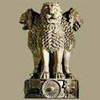National symbols of India defines the country’s character and have carefully picked. The national animal, Tiger symbolises power; the national flower, Lotus symbolises purity; the national tree, Banyan symbolises immortality, the national bird, the Peacock symbolises elegance and the national fruit, Mango symbolises the tropical climate of India.
Similarly, our national song and national anthem were a source of inspiration during the freedom struggle. The national emblem of India depicts four lions standing back to back, symbolising power, courage, pride and confidence. The game of hockey was at its peak when it was adopted as the national game of India.
Here is some more information about the national symbols of India:

Which is the National Bird of India?
The Peacock is the national bird of India, commonly known as the Indian peafowl was declared the national bird of India in 1963 because it was entirely a part of Indian custom and culture. A peacock is a symbol of grace and beauty. Another reason why the peacock was chosen as the national bird was because of its presence across the country, so much so that even common citizens are familiar with the bird. Moreover, no other country had the peacock as its national bird either. The peacock fulfilled all this criteria and hence became the national bird of India.

Which is the National Animal of India?
The answer is Tiger, Tiger is the national animal of India also known as the Lord of the Jungle and displays India’s wildlife wealth. The scientific name of Tiger is Panthera Tigris. Also, strength, agility and power are the basic aspects of the tiger. The Bengal Tiger was declared as the national animal of India in April 1973, with the initiation of Project Tiger, to protect the tigers in India. Prior to this until 1972, the lion was the national animal of India.

What is the National Anthem of India?
The national anthem of India is Jana Gana Mana. the Hindi version of an anthem that was originally composed in Bengali by Rabindranath Tagore. The original text composed in Bengali was written in 1905.Since the Bengali song ‘Vande Mataram’ faced opposition from non-Hindu segments of society, the Jana Gana Mana was adopted as the national anthem of India. On January 24,1950, the first stanza of Bharoto Bhagyo Bidhata was officially declared the National Anthem of India.

Which is the National Flower of India?
The lotus flower has a very significant position in Indian mythology. It is the flower of goddess Laxmi and symbolises wealth, prosperity, and fertility. Also, it grows very uniquely in dirty water with its long stalk far above the water, bearing the flower on the top. The lotus flower remains untouched from impurity. It symbolises purity, achievement, long life, and good fate.

Which is the National Fruit of India?
Mango is the national fruit of India, mangoes are native to India and are also known to be ‘Food of the Gods’. Since time immemorial, mangoes have been cultivated in India. In ancient times as well, the deliciousness of mangoes has been defined by many renowned poets. The great Mughal emperor Akbar had planted about 1,00,000 mango trees in Lakhi Bagh in Darbhanga. India is known to be the largest producer of Mango and accounts for more than 50% of total mango being exported around the World.

What is the National Song of India?
Vande Mataram is the national song of India. India’s national song was composed in Sanskrit by Bankimchandra Chatterjee. It has inspired many freedom fighters during the freedom struggle. Initially ‘Vande Mataram’ was the national anthem of India, but after independence ‘Jana Gana Mana’ was adopted as the national anthem. This was done because non-Hindu communities in India had considered Vande Mataram as biased. These communities felt that the nation was represented by ‘Maa Durga’ in the song. So that is the reason it was made the national song of India and not the national anthem.

The National Flag of India.
The national flag of India is horizontal rectangular in shape and has three colours – deep saffron, white and green with Ashoka chakra (Wheel of Law) at its centre. The Saffron in the flag represents strength and courage, the white in the middle tells us about peace, while the green at the bottom tells us about growth and fertility of the Land. Also, the chakra(wheel) in the middle with 24 spokes represent 24 hours of the day and that talks about constant movement in life. It was adopted on July 22, 1947, during a meeting of the Constituent Assembly. It is also called a tricolor. The flag was designed by Pingali Venkayya. The flag was hoisted by the first Indian Prime Minister Jawaharlal Nehru in 1947.

Which is the National Game of India?
Hockey is the national game of India. Hockey when declared as the national game was very popular. The game has seen a golden era during 1928-1956 when India won 6 consecutive gold medals in the Olympics. Hockey was considered the national game because of its unmatched distinction and incomparable talent at the time. At that time India had played 24 Olympic matches and won all of them.

What is the National Tree of India?
The national tree of India is the Banyan. The Banyan tree represents eternal life, because of its ever-expanding branches. The country’s unity is symbolised by the tree’s huge structure and its deep roots. The tree is also known as Kalpavriksha, which means ‘wish fulfilling tree’ .The Banyan tree is called so because the Banyan tree has immense medicinal properties and is associated with longevity. The Banyan tree also gives shelter to many different kinds of animals and birds, which represent India and its people from different races, religions and castes.

What is the National Emblem of India?
The Lion Capital of Ashoka at Sarnath is the national emblem of India. It consists of four Lions standing back to back on a circular abacus. The abacus has sculptures of an elephant, a horse, a bull and a lion. These are separated by wheels in between called the Dharma Chakras. The Lotus was removed from the Emblem and instead the motto Satyameva Jayate meaning ‘Truth Alone Triumphs’ was added below the State Emblem of India.

Which is the National River of India?
The Ganges or Ganga is the national river of India. According to the Hindus, this is the most sacred river on the earth. In fact, they perform many rituals on the bank of this river. The Indian cities which are famous for this river are Varanasi, Allahabad and Haridwar. Ganga flows over 2510 km of mountains, plains and valleys, and is the longest river in the country.

What is the National Currency of India?
Indian Rupee (INR) is the official currency of the Republic of India. The flow of this currency is controlled by the Reserve Bank of India. The symbol of the Indian rupee is derived from the Devanagari consonant “र” (ra). The Indian rupee is named after a silver coin, which is called Rupiya. It was first issued by Sultan Sher Shah Suri in the 16th century and later the Mughal Empire continued it.

Which is the National Heritage Animal of India?
The national heritage animal of India is Elephant. The Indian elephant is a subspecies of the Asian elephant and found in mainland Asia. It is listed as one of the endangered animals by the International Union for Conservation of Nature (IUCN). It can be spotted in four different regions in the country. Elephants were given the Heritage tag in 2010 by the Environment Ministry

Which is the National Aquatic Animal of India?
The national aquatic animal of India is River Dolphin, which is also called the Ganges river dolphin. The mammal once used to live in the Ganges, Brahmaputra and Meghna, Kamaphuli and Sangu rivers of India, Bangladesh and Nepal. However, the species is no more found in its early distribution ranges. The river dolphin is essentially blind and lives only in freshwater. The reason it was declared the national aquatic animal of India was done to save it from the brink of extinction.

Which is the National Reptile of India?
With its length up to 18.5 to 18.8 ft (5.6 to 5.7 m), King Cobra is the national reptile of India. This venomous snake is found in forests in India through Southeast Asia. It preys on other snakes, lizards and rodents. It has its cultural significance as Hindus worship this reptile.
हिंदी में पढ़ने के लिए यहां क्लिक करें
Related Links: Why India Matters | Indian National Flag | National Song of India | National Anthem of India | National Library of India





